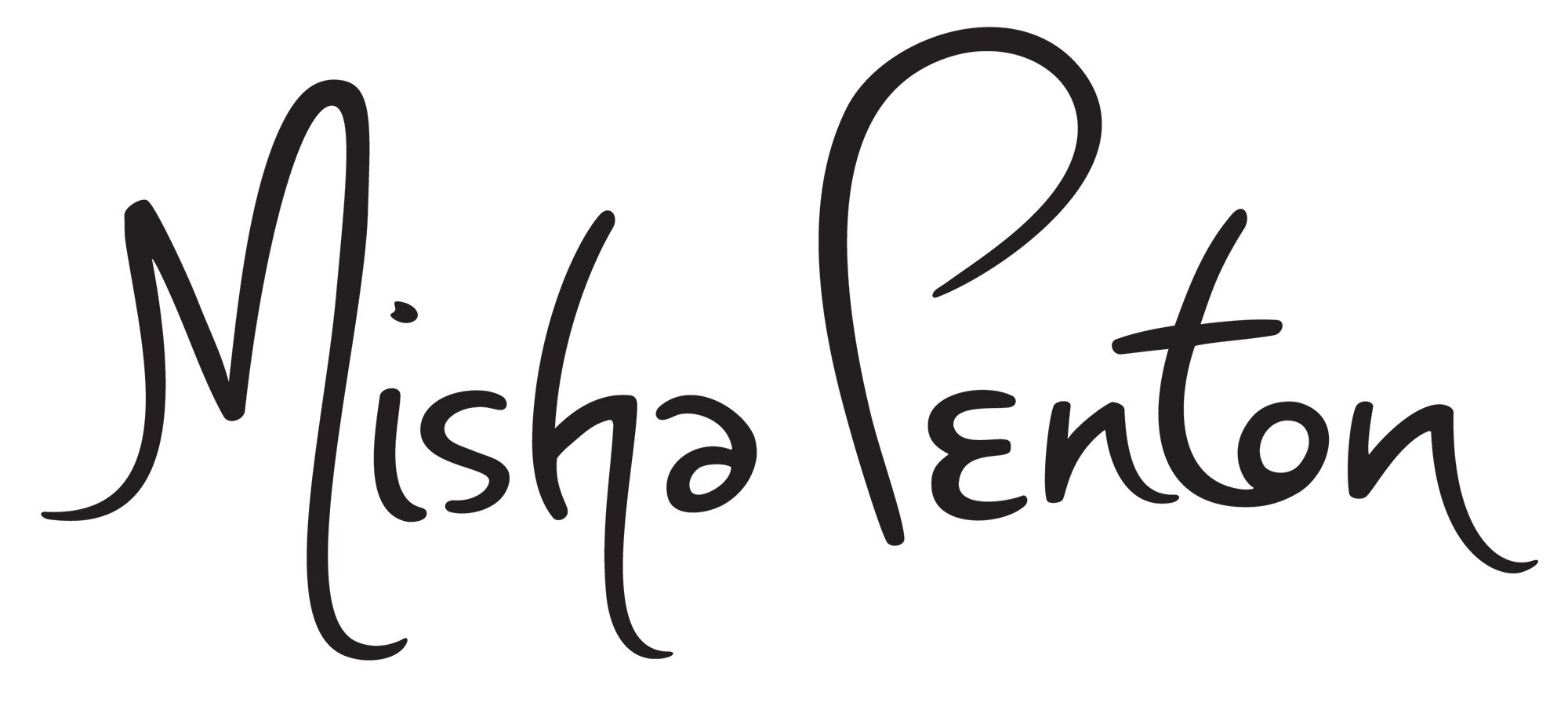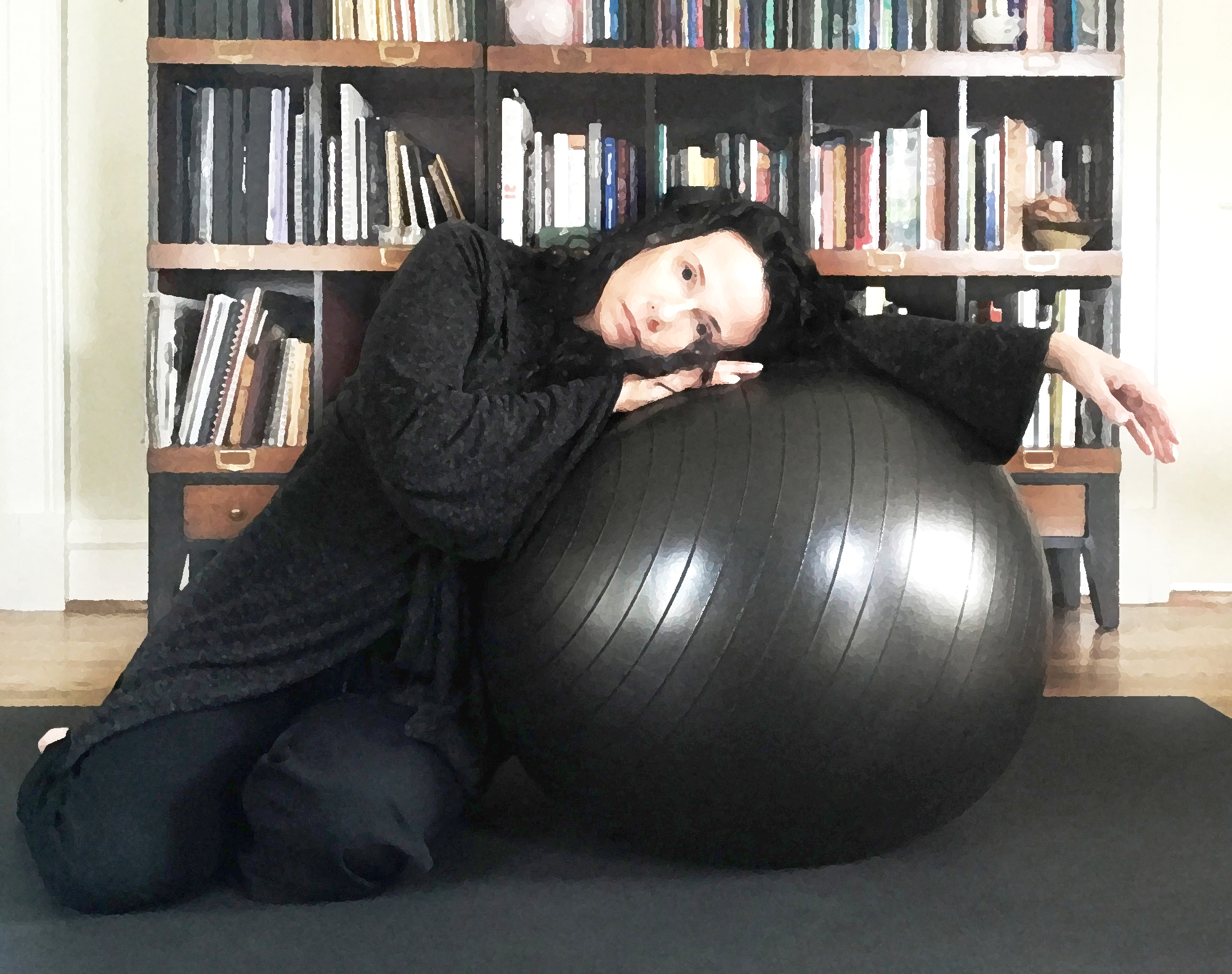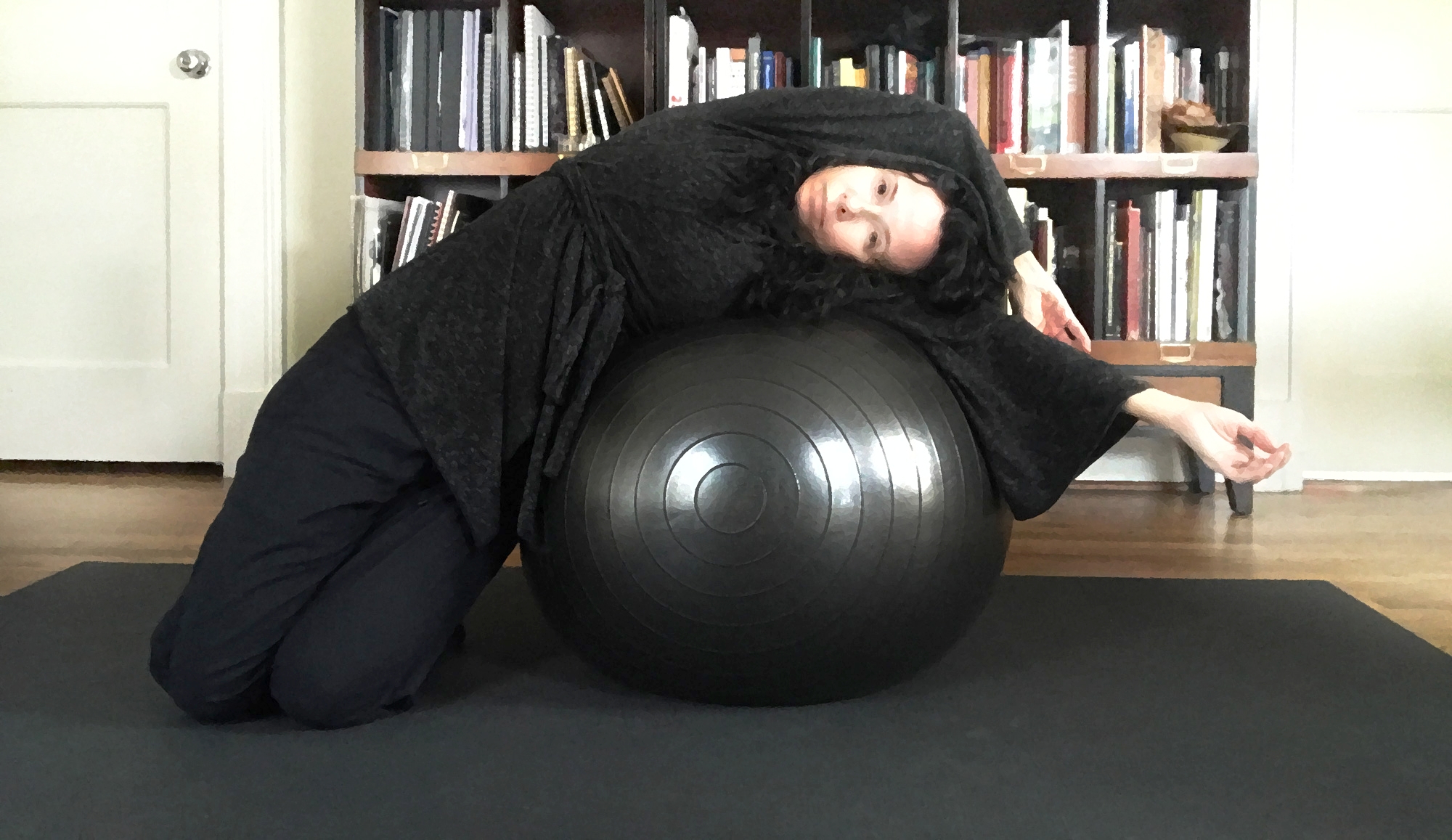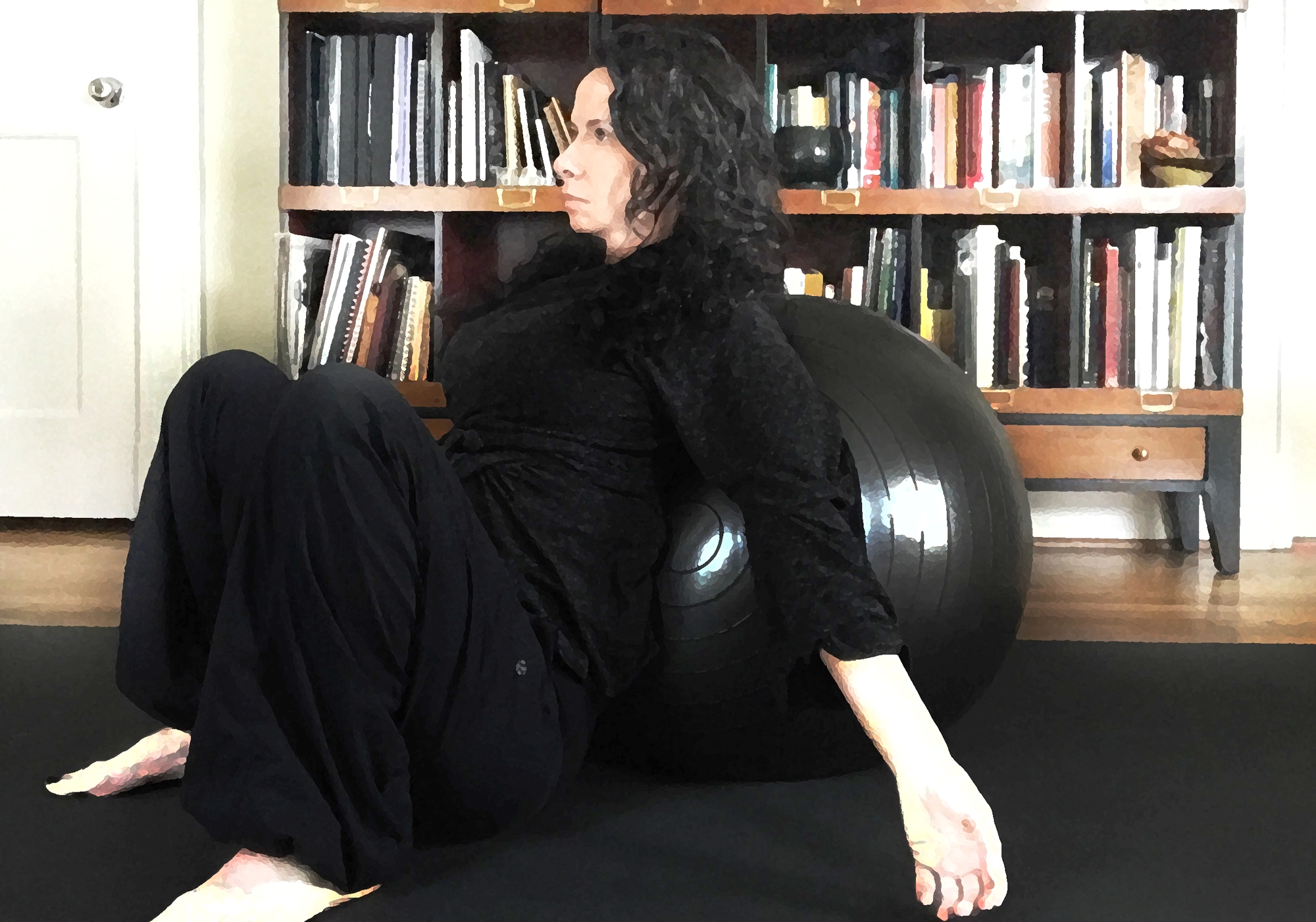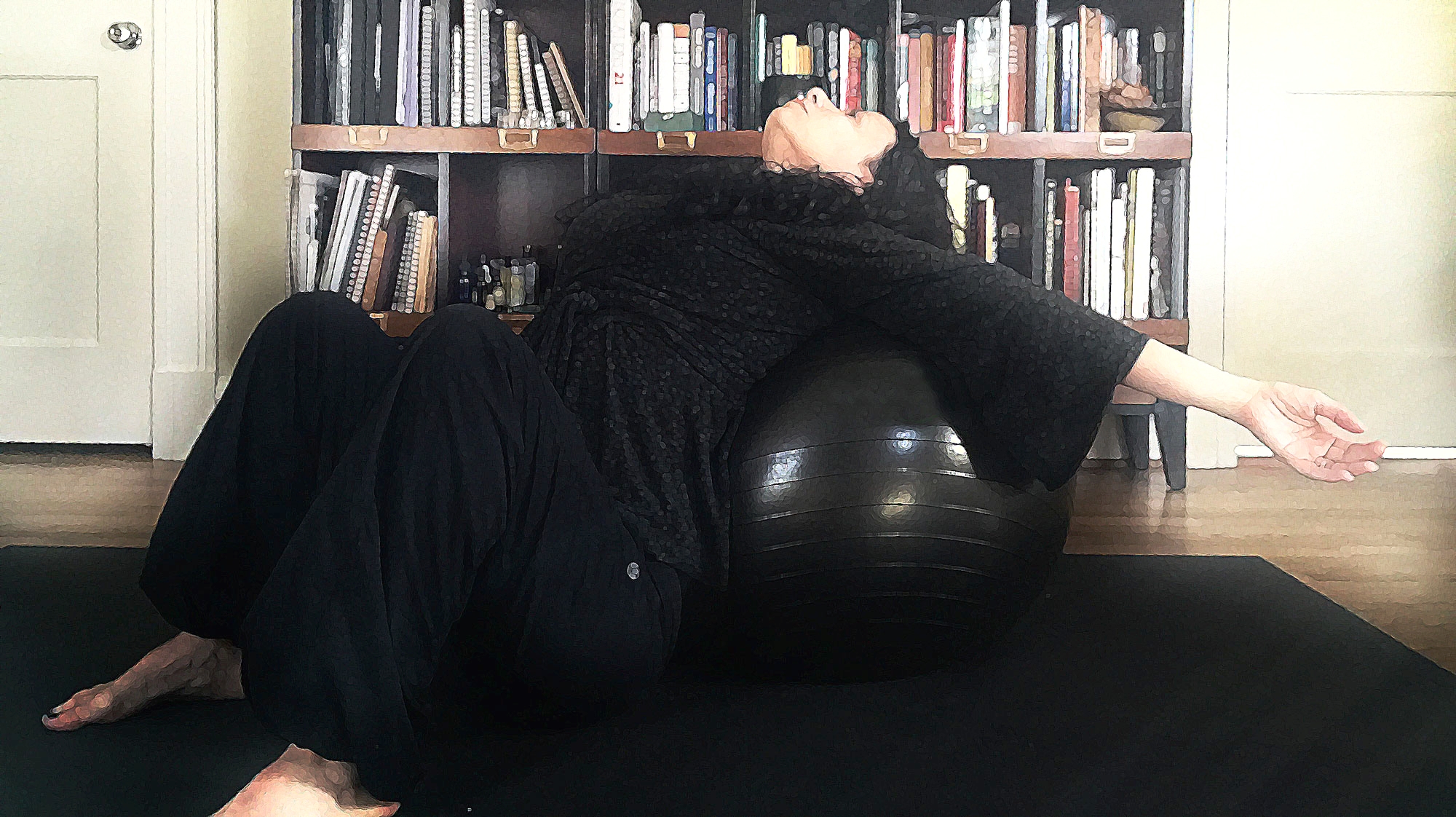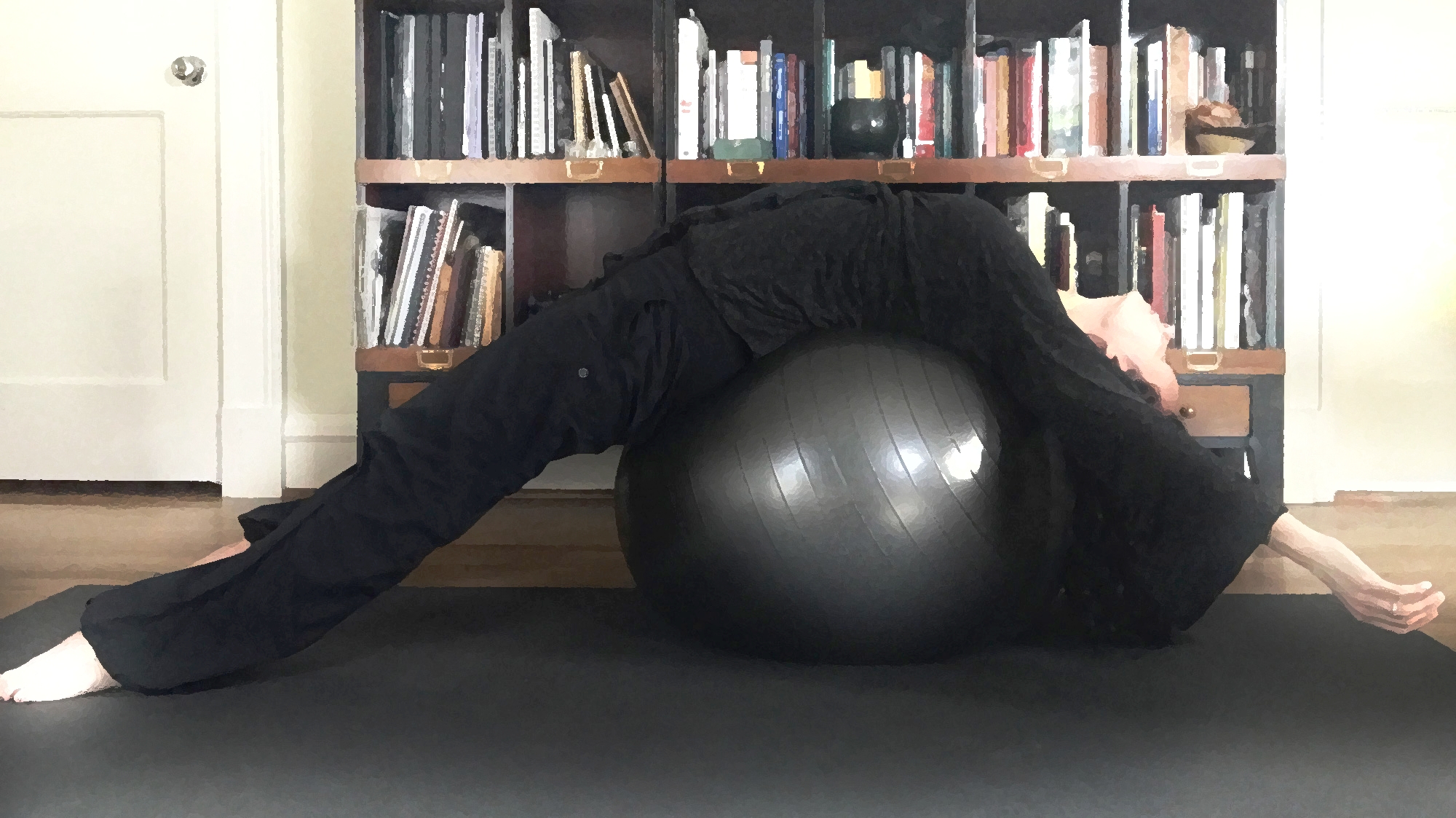Captain's Log: Notes from the Studio
The Laboratory of Vocality
My voice is my laboratory— the practice and process, itself, determines the shape of the creative work.
On the Ball
I work a lot with a physio ball, focussing on the flexibly and opening of the rib cage by leaning into the ball with my back, sides and full torso. This helps with the idea of opening the whole torso to breath and breathing with and into the side-body and back-body. Conceptually, vocal sound is powered low in the torso, from the pelvic bowl— what I call the pelvic crucible— the forge of breath. The awareness of the pelvic bowl in the back creates a 360 degree space with the capacity to expand with breath, low in the body. Singers and teachers describe this feeling-phenomenon in many ways. Kirsten Flagstad , a monumental 20th century soprano who died in the 1960s, "often spoke about her body connection and the feeling of 'singing from the back muscles to the ring with the feeling of no throat." 1
Jerzy Grotowski, the influential 20th century director, actor, and performance theorist wrote, “All true reaction begins inside the body.” 2 Grotowski called this pelvic bowl area, "la croix": "the cross" or “the sacrum-pelvis complex”— "that part of the body comprising the lower part of the spinal column (the coccyx) as well as the whole base of the trunk up to and including the abdomen." 3 I trained in Grotowski's work in my undergrad theatre days, but thanks to singer and vocal pedagogue, Shannon Holmes for pointing out the Grotowski connection to my pelvic crucible concept.
I also love an idea I learned in a workshop with Meg Brooker (her company) who is a dance artist and scholar specializing in the work of Isadora Duncan, a foundational American modern dancer from the early 20th century. Let's see if I can describe it: a cornerstone of the Duncan technique is the lifting and leading of the sternum, so much so, that after the workshop, my whole torso was sore for a few days from this immense lift. With this concept in mind, there is an intense sense of lightness to the body in motion. I emailed Meg about Isadora's ideas and she sent back an interesting quote:
Meg Brooker, dancer, choreographer, and dance scholar.
"I spent long days and nights in the studio seeking that dance which might be the divine expression of the human spirit through the medium of the body's movement. For hours I would stand quite still, my two hands folded between my breasts, covering the solar plexus. . . . I was seeking and finally discovered the central spring of all movement, the crater of motor power, the unity from which all diversities of movement are born, the mirror of vision for the creation of the dance. It was from this discovery that was born the theory on which I founded my school. The ballet school taught the pupils that this spring was found in the center of the back at the base of the spine...
...After many months, when I had learned to concentrate all my force in this one center, I found that thereafter when I listened to music the rays and vibrations of the music streamed to this one fount of light within me, where they reflected themselves in Spiritual Vision, not the mirror of the brain but of the soul; and from this vision I could express them in Dance...."
— Isadora Duncan from "Fragments and Thoughts," The Art of the Dance.
If those two paragraphs don't inspire you, you're dead.
I love how Isadora locates the solar plexus high in her body, between her breasts.
Now, I know, I know, the last thing us singer types wanna do is puff up our chests and breathe shallowly, but that's not what I'm talking about here.
If energy is moving up and out from the sternum-solar plexus on a diagonal that is deeply connected to and rooted in the 360 degree pelvic bowl-"la croix"-"sacrum-pelvis complex”-pelvic crucible-forge with its energy moving down and out on a diagonal, then what we have is this amazing energetic engine powered by:
“Diametric opposition”
Diametirc opposition is energy or motion directed or moving in opposite directions, like so:
The back-body is engaged with energy moving downward and at the same time the sternum / solar plexus lift moves upward— this provides an enormous sense of space in the torso and rib cage. The pelvic crucible connection and expansion drives and reciprocates the energy and lift of the sternum. Length!
I think I hear a ring in the tone, here, people!
“Resonance!”
There are lots of ways to work with diametirc opposition— the most classic, perhaps, is gently pressing the feet into floor as the crown of the head lifts, with the knees soft, shoulders releasing down the back, and pelvis is free.
Something Old, Something New
Because of the contemporary music I sing as an interpretive artist and the music I compose for my voice, I continue to practice repertoire from the classical vocal canon. No matter how "out there" I feel like I get, a solid technique is the foundation of my vocal work.
I took up fellow soprano Courtney Ruckman's January practice challenge— she created a month-long daily technique course. Courtney's series of chosen vocalises include combinations of exercises from some oldskool vox texts: Marchesi book 1, Liebling, Lamperti, Viardot book 1, and Viardot book 2.
Yummy.
It's coming to a close now, but it can be picked up any time: follow along and / or join on Twitter using the hashtag #practicetweets. Satie songs also pop up routinely in my warm-up, and I always keep some new old things on my music stand, like, I don't know: Gluck arias, for instance.
New Works
Having studied with radical vox mentor Richard Armstrong, who worked extensively with groundbreaking voice artist, Roy Hart, I have the wings needed to do the work I'm doing now. The transition to my new works and new projects has felt excruciatingly slow, with the trajectory of the transformation dating back — at least somewhat detectably— a good three years, or so. Now, especially with the burgeoning Medusa Project, I have very clear ideas and clear experimental voice compositional techniques which are emerging through daily experiments and improvisations with poetics and voice in my Laboratory of Vocality!
“Through repetition the magic is forced to rise.”
I continue to work extensively with my Medusa poetics / text / libretto. Through the process, edits or changes become obvious as my voice drives the work— my voice tells me what to do; my voice tells the words what to do; and the words, text and sonority shape the vocalization / vocality.
Memorizing the Medusa text is my focus, right now. It's through working with memorization and then with the memorized text, that the piece will take flight.
Come to the Bechdel Film Festival at 14 Pews in Houston and see the screening of my experimental voice and film short, Digital Medusa. February 15 - 20. Or see the live performance premiere of The Medusa Project on April 7 at The Women Composers Festival of Hartford.
Resources
Duncan, Isadora. "Fragments and Thoughts." The Art of the Dance. Theatre Arts Books, 1970.
Grotowski, Jerzy. "Les Exercises." Il Teatr Labroratorium di Jerzy Grotowski 1959-1969, edited by Ludwik Flaszen and Carla Pollastrelli, Unpublished translation by James Slowiak. Fondazione Pontedera Teatro, 2001. 87-131.
Grotowski, Jerzy. "Tue es le fils de quelqu'un." The Grotowski Sourcebook, edited by Richard Schechner and Lisa Wolford. English version revised by J. Grotowski, translated by James Slowiak. Routledge, 2001. 294-305.
Jones, David. "The Dangers of Undersinging Large or Dramatic Voices." The Voice Teacher. 2006. N.p.
Slowiak, James, and Jairo Cuesta. Jerzy Grotowski. Routledge, 2007.
